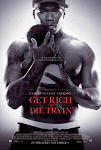The intro of the movie starts with the name of the institution and a track of 50Cent "i'll whip ya head boy" is played on, and the credits are shown on the screen, the name of the director and the name of the actors, the name of the song played on.
as the credits and the song of the intro are played on, there is a long shot from the side mirror of the 50cent's car showing cars driving during the night which is low-key-lighting and the only lights turned are the lights of the city and showing many cars driving at the same time which is indicating it is a busy city.
then the camera zooms on 50Cent's car and mainly a close up on 50cent's face which is indicating that he is the protagonist because he's the first character seen and he is shown as serious and that something is going to happen, and there is a white boy in the car looking scared, and then we see a man holding a gun and hugging the white boy so that is showing that something is going to happen to him and that is now related to the name of the song and which makes sense.
Then other members of the gang are shown in the car, so that is indicating that they are the main characters of the movie, at the end the car is still shown from a long shot from the outside and then it zooms up to the screen again as parts of the location are being seen.

